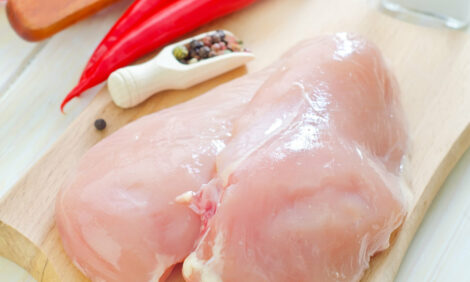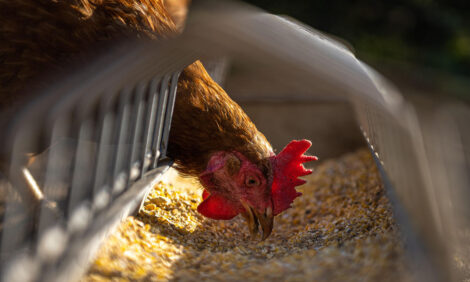



Marginal Fall in Animal Feed Output in Great Britain
The overall output of 9.140 million tonnes of compound feed in 2008 was just 0.5 per cent lower than the previous year but the average hides markedly different trends for the various livestock sectors, writes ThePoultrySite editor, Jackie Linden. There were small increases in the output of feeds for cattle and poultry but pig feed production was down by almost ten per cent compared to 2007.According to the latest national statistics produced by the Department for Environment, Food and Rural Affairs (Defra) on animal production in Great Britain (GB), and comparing production in December 2008 with the same month in 2007, total retail production of animal feed was down 1.6 per cent, feed raw material usage in the retail animal feeds was down 1.3 per cent and GB integrated feed production was down 1.4 per cent.
Turning to the annual figures for 2008, total output of compounds, blends and concentrates (9.140 million tonnes) in retail feeds is down 0.5 per cent compared to the previous year. When all other feed ingredients fed straight, e.g. flaked maize, other maize products and molassed products are included, total output is 9.275 million tonnes or 0.7 per cent lower than 2007.
Feed production for cattle and calves in 2008 stood at 3.914 million tonnes, an increase of 1.6 per cent over the previous year. Production figures (and percentage changes) were as follows: all calf feed, 171,200 tonnes (+5.2 per cent); compounds for dairy cows, 2.064 million tonnes (-2.1 per cent); blends for dairy cows, 647,000 tonnes (+17.7 per cent); all other cattle feed, 682,000 tonnes (-0.2 per cent); all other cattle blends, 289,00 tonnes (+1.4 per cent) and protein concentrates, 61,300 tonnes (-4.4 per cent).
The figures for pig feed production are alarming, showing significant falls for all age groups and reflecting the very challenging times faced by the industry last year. At 1.451 million tonnes, total pig feed production in 2008 was 9.8 per cent lower than the previous year. Production figures (and percentage changes) were as follows: starters and creep feeds, 59,100 tonnes (-21.9 per cent); link/early grower feeds, 64,400 tonnes (-7.6 per cent); grower feed, 350,000 tonnes (-8.0 per cent); finisher feed, 595,00 tonnes (-8.2 per cent); breeder feed, 367,000 tonnes (-12.4 per cent) and protein concentrates, 14,900 tonnes (-2.6 per cent).
Poultry feed output is covered separately for retail feed companies (independents and co-operatives & nationals) and integrators. Total production for the two groups, respectively was 2.583 million tonnes (+1.2 per cent) and 3.020 million tonnes (+1.9 per cent).
For both groups combined, total poultry feed production in 2008 was 5.318 million tonnes, 1.8 per cent more than in the previous year. For the poultry types, feed production figures (and percentage changes) were as follows: broiler feed, 3.105 million tonnes (+1.8 per cent); turkey feed, 525,000 tonnes (-0.7 per cent); layer feed, 1.163 million tonnes (+2.7 per cent) and breeder & rearing feed, 525,000 tonnes (+1.9 per cent).
For the poultry feed retailers, production figures (and percentage changes) were as follows: chick rearing feed, 123,000 tonnes (+8.1 per cent); layer feed, 928,000 tonnes (+4.1 per cent), broiler feed, 791,000 tonnes (-2.2 per cent); breeding and rearing feed, 251,000 tonnes (-3.5 per cent); turkey feed, 204,000 tonnes (+8.9 per cent); other poultry feeds, 284,000 tonnes (-2.1 per cent). Protein concentrates for poultry amount to just 1,500 tonnes (-8.8 per cent).
For the integrated poultry companies, feed production figures (and percentage changes) were as follows: broiler feed, 2.314 million tonnes (+3.2 per cent); turkey feed, 321,000 tonnes (-5.9 per cent); layer feed, 235,000 tonnes (-2.4 per cent) and breeder & rearing feed, 150,000 tonnes (+6.7 per cent).
For the other livestock species, sheep feed production in 2008 was 668,000 tonnes (+3.8 per cent) and for horse feed output was 197,000 tonnes (+2.8 per cent).
Defra will updated average feed prices for the quarter in April 2009. For the period July to September 2008 quarterly average prices (per tonne) of animal feedingstuffs were: cattle and calf feed, £206; pig feed, £219; poultry feed, £240 and sheep feed, £206.
The report also gives figures for raw material usage in feeds. Wheat remains the dominant cereal used in feeds in Great Britain but it was displaced to some extent by barley, oats and whole & flaked maize. Soybean meal remained the most commonly used oilseed, while the inclusion of sunflower, field beans and field peas dropped markedly.
The figures for poultry feed composition cover only cereal usage. Wheat was also by far the most widely used cereal in poultry feeds, but it was substituted with barley and other cereals in poultry feeds last year compared to 2007.
Further Reading
| - | You can view the full report by clicking here. |
February 2009








